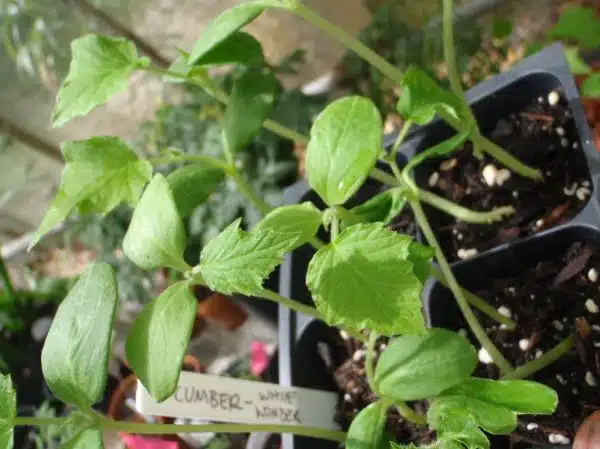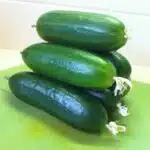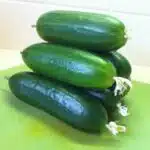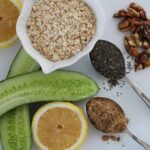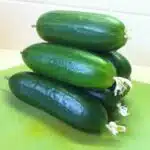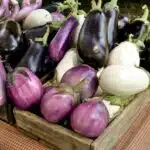Cucumbers are one of the most popular vegetables in the world, and there are plenty of varieties to choose from. If you’re looking for something unique and delicious, consider growing White Wonder cucumbers. These crisp, juicy cucumbers have a delicate flavor and are particularly popular in salads.
Growing White Wonder cucumbers is relatively easy, but it does require some basic knowledge and preparation. In this article, we’ll cover everything you need to know about cultivating these delicious vegetables. From choosing the right location for your garden to caring for your plants as they grow, we’ll provide all the tips and advice you need to successfully grow White Wonder cucumbers. Whether you’re an experienced gardener or just starting out, this guide will help you create a thriving cucumber garden that yields plenty of delicious fruits.
Understanding The White Wonder Cucumber Plant
The White Wonder cucumber plant is a marvel of nature, with its delicate white skin and succulent flesh. This plant is a great addition to any garden, providing both visual appeal and delicious produce. The White Wonder cucumber plant is known for its distinctive characteristics that distinguish it from other varieties of cucumbers.
One of the most notable characteristics of the White Wonder cucumber plant is its size. This plant can grow up to six feet in length, making it one of the largest cucumber plants available. Additionally, this plant has a high yield rate and produces large quantities of fruit throughout the growing season.
To ensure optimal growth, the White Wonder cucumber plant requires specific growth requirements. These include full sun exposure, well-drained soil, and regular watering. It also needs support for climbing as this variety grows on vines. By providing these growth requirements, you can ensure that your White Wonder cucumber plant will thrive and produce an abundance of delicious cucumbers.
As you prepare to cultivate your own White Wonder cucumber plants, it’s important to choose the right location for your garden plot. By selecting an area with full sun exposure and well-drained soil, you can create an optimal growing environment for your plants. With these steps in place, you’ll be on your way to cultivating a bountiful harvest of delicious and nutritious cucumbers!
Choosing The Right Location For Your Garden
Understanding the White Wonder Cucumber Plant provides a solid foundation for cultivating a healthy and thriving crop. However, choosing the right location for your garden is just as crucial. White Wonder cucumbers thrive in warm weather, so it’s essential to select an area with plenty of sunlight. The plant requires at least six hours of direct sunlight daily, making it imperative to choose a location with ample exposure to the sun.
Soil pH levels are also crucial when growing White Wonder cucumbers. These plants prefer soil pH levels between 6.0 and 7.5, which is slightly acidic to neutral. It’s best to test your soil before planting to ensure that it meets these requirements. If the soil is too acidic or alkaline, you can adjust it by adding lime or sulfur accordingly.
Once you’ve identified a suitable location for your garden and tested the soil, it’s time to prepare the ground for planting. Preparing your soil for planting involves a few essential steps like removing any weeds or debris from the area and tilling the soil thoroughly. You may also want to add some organic matter like compost or well-rotted manure to provide essential nutrients for your plants’ growth and development.
Transition: Now that you understand how sunlight requirements and soil pH levels impact White Wonder cucumber growth, let’s delve into preparing your soil for planting these delicious vegetables.
Preparing Your Soil For Planting
As the saying goes, “a fertile soil is like a bank account, you can’t withdraw what you haven’t deposited.” This holds true for growing white wonder cucumbers. If you want to have a bountiful harvest, start by ensuring that your soil has the right nutrients. One way to determine this is by conducting a soil test. This will provide information on the levels of nitrogen, phosphorus, and potassium in your soil. Based on this information, you can supplement your soil with appropriate fertilizers.
Composting techniques are also an excellent way of preparing your soil for planting white wonder cucumbers. Compost helps improve the texture of the soil by increasing its water-holding capacity and adding organic matter that releases nutrients slowly into the plant roots. You can make compost from kitchen scraps, grass clippings or leaves. The process involves layering these materials in a pile and regularly turning it to ensure proper decomposition.
By utilizing both soil testing and composting techniques, you can prepare your garden bed for planting white wonder cucumbers successfully. In addition, it’s essential to ensure that the soil is well-drained and aerated before planting. These critical steps will create an environment where cucumber seeds can thrive and develop into healthy plants ready for transplanting outdoors. In the subsequent section, we’ll discuss starting your seeds indoors to give them a good head start before transplanting them outside.
Starting Your Seeds Indoors
Seed starting is an essential step when growing White Wonder cucumbers. Starting your seeds indoors will give you a head start on the growing season and ensure that your plants are healthy and robust. Here are some seed starting tips to help you get started.
First, choose a suitable indoor gardening setup for your seedlings. Ensure that the area where you plan to grow your seeds has enough natural light or invest in artificial lighting if necessary. You will also need a container with drainage holes, good quality soil, and a watering can or spray bottle. It’s crucial to keep the soil moist but not too wet to prevent fungus growth or damping off.
Secondly, when sowing White Wonder cucumber seeds indoors, ensure that you follow the packet instructions on seed depth and spacing. Generally, plant the seeds at least 1/2 inch deep and 1-2 inches apart. Cover lightly with soil and water gently, ensuring that the seeds are not disturbed. Maintain consistent temperatures of between 60-75°F to encourage germination.
In conclusion, starting your White Wonder cucumber seeds indoors is an excellent way to get a head start on the growing season. By following these seed starting tips and providing your seedlings with adequate light, moisture, and warmth, you will have healthy plants ready for transplanting outdoors in no time. Next up – transplanting your seedlings into their permanent home!
Transplanting Your Seedlings
Once your seedlings have developed their second set of leaves, it is time to transplant them into larger containers. Hardening off your seedlings is crucial before transplanting. This process involves gradually exposing the plants to outdoor conditions, such as wind and direct sunlight, for a few hours each day. Optimal timing for hardening off is about one week before transplanting.
Before planting your seedlings in their permanent location, it is important to protect them from transplant shock by gradually acclimating them. Transplant shock can occur when the plant experiences a sudden change in environment or temperature. To prevent this, gradually introduce your seedlings to their new surroundings by increasing their exposure to sunlight and reducing watering frequency.
Once your seedlings are fully acclimated, you can safely transplant them into your garden or larger containers. In the subsequent section, we will discuss how to properly water and care for your plants after transplantation to ensure optimal growth and yield.
Watering Your Plants
- When it comes to watering white wonder cucumbers, a gardener should be aware of the frequency and amount of water that is being used.
- Generally, white wonder cucumbers should be watered every other day when the soil is dry, using enough water to moisten the soil but not to flood it.
- Depending on the temperature and humidity, the amount of water that is used should be adjusted accordingly; for instance, in hot and dry weather, more water will be necessary.
- Finally, it is important to monitor the soil moisture level to ensure that the white wonder cucumbers are receiving the right amount of water.
Frequency Of Watering
It is essential to establish a consistent watering schedule for white wonder cucumbers to ensure healthy growth and yield. These plants require an adequate amount of moisture to thrive, but overwatering may lead to root rot and other fungal diseases. It is crucial to maintain the right balance of moisture in the soil by following an appropriate watering schedule.
The frequency of watering white wonder cucumbers depends on various factors such as weather conditions, soil type, and stage of growth. During hot and dry seasons, these plants may require more frequent watering than during cooler periods. Sandy soils tend to drain water quickly, while clay soils retain more moisture; therefore, it is necessary to adjust the watering schedule accordingly.
To determine when to water white wonder cucumbers, one should check the soil’s moisture level regularly. Insert a finger into the ground up to two inches deep – if it feels dry at this depth, it’s time to water. Avoid overhead watering as it can result in foliage diseases; instead, use drip irrigation or a soaker hose for efficient watering. Following a proper watering schedule that meets the plant’s moisture requirements will ensure healthy growth and high-quality fruit production.
Amount Of Water
Watering frequency and the amount of water are crucial factors in maintaining healthy plants. In determining how much water to use, it is essential to consider the soil moisture level and the plant’s needs. Overwatering can lead to root rot, while underwatering can cause stunted growth and poor fruit production. Therefore, it is necessary to establish a consistent watering schedule that meets the plant’s moisture requirements.
The amount of water needed for plants varies depending on several factors, such as weather conditions, soil type, and stage of growth. During hot and dry seasons, plants may require more frequent watering than during cooler periods. Sandy soils tend to drain water quickly, while clay soils retain more moisture; thus, adjustments in watering frequency should be made accordingly.
To determine the appropriate amount of water for plants, one should check the soil moisture level regularly. Insert a finger into the ground up to two inches deep – if it feels dry at this depth, it is time to water. It is essential to ensure that the entire root zone receives adequate moisture by applying enough water slowly and deeply rather than frequent shallow watering. Following these guidelines will help maintain healthy plants with high-quality fruit production.
Fertilizing Your Cucumbers
One of the most important aspects of growing healthy and productive white wonder cucumbers is proper fertilization. Fertilizers provide essential nutrients that are necessary for plant growth and development. There are two types of fertilizers available for your cucumbers: organic and synthetic.
Organic fertilizers are derived from natural sources, such as compost, manure, or bone meal. They are slow-release fertilizers that slowly release nutrients into the soil over time. Organic fertilizers improve soil health by increasing its fertility and adding beneficial microorganisms to it. They are also safe for the environment and do not harm beneficial insects such as bees or ladybugs.
Synthetic fertilizers, on the other hand, are made from chemical compounds that are designed to quickly supply nutrients to plants. They are fast-release fertilizers that can be absorbed by plants within hours of application. However, they have a downside in that they can cause soil degradation over time due to their high salt content. Therefore, it is important to use them sparingly and only when necessary.
To ensure optimal growth of your white wonder cucumbers, follow these tips when fertilizing:
- Test your soil before applying any fertilizer to determine its nutrient composition.
- Apply fertilizer at the right time – usually when plants start flowering.
- Avoid over-fertilization as it can cause root burn or stunt plant growth.
- Water your plants before applying fertilizer – this ensures better absorption of nutrients.
- Rotate between organic and synthetic fertilizers to avoid soil depletion.
Now that you know how to properly fertilize your white wonder cucumbers, let’s move on to trellising or staking your plants for maximum yield potential.
Trellising Or Staking Your Plants
As mentioned earlier, white wonder cucumbers are known for their sprawling vines that can take up a lot of space in your garden. However, with vertical gardening techniques, you can save space and make the most out of your garden. Trellising or staking your plants is an excellent way to keep them off the ground and prevent diseases caused by soil-borne pathogens.
Trellising involves training your cucumber vines to grow vertically using sturdy support structures such as wooden stakes or wire cages. This method not only saves space but also allows for better air circulation and easier harvesting. On the other hand, staking involves tying the main stem of each cucumber plant to a tall stake using twine or strips of cloth. This method helps keep the plants upright and prevents them from sprawling on the ground.
Companion planting is another effective way of maximizing space in your garden while also promoting healthy growth for white wonder cucumbers. Consider planting herbs such as basil, mint, or cilantro near your cucumber plants as they help repel pests and attract beneficial insects like bees and ladybugs. Additionally, intercropping with other vegetables such as lettuce, spinach or radishes can help boost soil fertility by adding nutrients and organic matter through their decomposing leaves.
To maintain healthy white wonder cucumbers throughout the growing season, it’s important to manage pests and diseases effectively. In the subsequent section, we will discuss some common pests and diseases that affect cucumber plants and how to prevent them from causing damage to your crop.
Managing Pests And Diseases
Pests and diseases can be a significant challenge when growing white wonder cucumbers. For this reason, it is vital to identify the potential pests and diseases that may affect your plants. You can do this by regularly inspecting your plants for any signs of damage or discoloration.
Identifying pests is crucial in determining the best control method to use. Common pests that attack cucumber plants include aphids, spider mites, cucumber beetles, and squash bugs. Aphids are small insects that feed on plant sap, causing stunted growth and yellowing leaves. Spider mites are tiny arachnids that infest the undersides of leaves, causing yellow spots and webbing. Cucumber beetles feed on leaves, flowers, and fruits while transmitting bacterial wilt disease. Squash bugs also feed on foliage and transmit bacterial wilt disease.
Fortunately, there are natural pest control methods that you can use to manage pests without harming beneficial insects or pollinators. These methods include crop rotation, companion planting with herbs like basil or marigold flowers that repel pests, handpicking off larger insects like beetles or caterpillars, spraying neem oil or insecticidal soap solution directly onto affected areas and using row covers to prevent pest infestation. By implementing these natural pest control strategies early on in the growing season, you can help ensure a healthy harvest of white wonder cucumbers.
As you successfully manage pests and diseases in your cucumber garden, it is important to keep an eye out for signs of maturity in your white wonder cucumbers before harvesting them. The fruit should be firm to the touch with a slightly glossy appearance when ripe for harvest. Additionally, the skin should be smooth with no traces of yellowing or soft spots. With proper management techniques in place throughout the growing season, you can enjoy a bountiful harvest of fresh and delicious white wonder cucumbers!
Harvesting Your Cucumbers
As your white wonder cucumbers ripen, they will become a stunning sight in your garden. The white exterior of the cucumber will contrast beautifully with the green leaves around it, making it easy to spot when it’s ready for harvesting. The fruit should be firm and about six to eight inches long, with a diameter of two to three inches.
When harvesting your cucumbers, it’s important not to pull or twist them off the vine. Instead, gently cut them off using a sharp knife or pruning shears. Be sure to leave about an inch of stem on the cucumber as this will help extend its shelf life. If you plan on using pickling techniques or preserving methods, it’s best to harvest your cucumbers when they are still small and tender.
Once you have harvested all of your cucumbers, it’s time to think about storing and preserving them. You can keep them fresh by wrapping them in plastic wrap or placing them in an airtight container in the refrigerator. Alternatively, if you plan on pickling or preserving your cucumbers, be sure to follow proper food preservation techniques and recipes. By doing so, you’ll be able to enjoy the delicious taste of white wonder cucumbers all year round!
Storing And Preserving Your Cucumbers
Cucumbers should be stored in a cool, dry place, preferably at a temperature between 45 to 55 degrees Fahrenheit. To preserve cucumbers, pickling is the most popular method and is achieved by submerging cucumbers in brine and vinegar. White Wonder cucumbers are ideal for preserving, as they are low in water content and have a sweet flavor. When preparing cucumbers for preservation, it is important to use crisp, fresh vegetables and avoid those that have soft or mushy spots.
Storing Cucumbers
Cucumber preservation is a crucial aspect of gardening that ensures you have a steady supply of fresh cucumbers all year round. One effective method of preserving cucumbers for long term storage is freezing. To freeze your white wonder cucumbers, slice them into thin rounds or chop them into small pieces before placing them in an airtight container. Freezing helps to maintain the nutrients and flavor of the cucumber, making it ideal for use in salads, smoothies or sandwiches.
Another way to preserve your white wonder cucumbers is through pickling. Pickling involves immersing the sliced cucumbers in vinegar and spices to create a tangy and crunchy snack. The process also helps to extend the shelf life of your cucumbers by inhibiting bacterial growth. For best results, store your pickled cucumbers in sterilized jars with tight-fitting lids and keep them in a cool, dark place.
Lastly, if you prefer storing your white wonder cucumbers for short-term use, store them in the refrigerator’s crisper drawer. This area provides the ideal temperature and humidity conditions that help to keep the cucumbers fresh for up to two weeks. However, ensure that you don’t store other fruits such as apples alongside your cucumbers as they release ethylene gas which can accelerate spoilage. In conclusion, by using these methods of cucumber preservation, you can enjoy delicious white wonder cucumbers throughout the year while maintaining their freshness and nutritional value.
Preserving Cucumbers
When it comes to gardening, one of the most rewarding experiences is harvesting fresh produce from your own backyard. However, once you’ve harvested your cucumbers, it’s essential to store and preserve them correctly to extend their shelf life and ensure that you can enjoy their delicious taste for longer.
One popular method of preserving cucumbers is pickling. Pickling involves immersing sliced cucumbers in a mixture of vinegar and spices, creating a tangy and crunchy snack that can be enjoyed on its own or added to sandwiches and salads. The process also helps to inhibit bacterial growth, extending the shelf life of your cucumbers.
Another effective way to preserve cucumbers is by freezing them. Freezing allows you to enjoy the nutritional benefits of cucumbers year-round while maintaining their flavor and texture. To freeze your cucumbers, slice them into thin rounds or chop them into small pieces before placing them in an airtight container. This technique is ideal for use in smoothies or as a refreshing addition to salads.
In conclusion, preserving your cucumbers through pickling or freezing techniques allows you to enjoy a steady supply of fresh produce all year round while maintaining their nutritional value. Whether you prefer the tangy crunch of pickled cucumbers or the refreshing taste of frozen slices, these preservation methods provide excellent options for storing your harvest for future use.
Using White Wonder Cucumbers In Recipes
White Wonder cucumbers are a great addition to any kitchen, whether you are an experienced chef or a novice cook. These cucumbers have a unique flavor that is both sweet and tangy, making them perfect for use in a variety of dishes. There are many different White Wonder cucumber recipes available online, from simple salads to more complex dishes like cucumber gazpacho.
One of the health benefits of using White Wonder cucumbers in your cooking is that they are low in calories and high in fiber. They also contain vitamin C and other antioxidants, which can help boost your immune system and lower your risk of certain diseases. Additionally, the skin of the cucumber contains silica, which can help improve the health of your skin, hair, and nails.
If you’re looking for new ways to incorporate White Wonder cucumbers into your diet, there are many recipes available online that you can try. Some popular options include cucumber salad with feta cheese and dill, cucumber sandwiches with cream cheese and herbs, and homemade pickles made with White Wonder cucumbers. Whether you’re looking for a light summer snack or a hearty meal, there’s sure to be a recipe out there that will suit your tastes.
Transition: While using White Wonder cucumbers in your cooking can be a delicious and healthy choice, there are some common issues that gardeners may encounter when growing these plants. In the next section, we’ll take a look at some of these issues and provide tips for troubleshooting them.
Troubleshooting Common Issues
Theory has it that white wonder cucumbers are relatively easy to grow, but this is not always the case. In fact, these plants are susceptible to various diseases and pests that can reduce their productivity. Identifying the diseases and pests that could affect your crop is imperative for healthy plant growth.
Identifying diseases is an essential part of growing white wonder cucumbers successfully. Common cucumber diseases include powdery mildew, downy mildew, bacterial wilt, and cucumber mosaic virus. Powdery mildew appears as a white powdery substance on leaves and stems, while downy mildew causes yellow patches on the leaves’ surface. Bacterial wilt causes wilting of the plant’s leaves and stems, while cucumber mosaic virus leads to distorted growth patterns in young plants.
Pest management techniques should also be used when growing white wonder cucumbers. Some common pests that pose a threat to these plants include aphids, spider mites, slugs, and snails. Using insecticidal soaps or neem oil can help control aphids and spider mites. Meanwhile, copper tape placed around the base of your containers will deter slugs and snails from eating your crop. Being proactive in identifying problems early on will ensure successful yields come harvest season.
Moving into tips for maximizing your yield, maintaining proper soil moisture levels is crucial for healthy plant growth. White wonder cucumbers require consistent watering throughout their growing season to avoid water stress that could impact production levels negatively. Additionally, pruning back excess foliage helps increase sunlight penetration into the canopy for better fruit development. Finally, using trellises or stakes will support heavy fruit loads and prevent them from touching the ground where they can become more prone to disease or rotting.
Tips For Maximizing Your Yield
To maximize the yield of your White Wonder cucumbers, you should consider companion planting. Companion plants are those that help each other grow and repel pests. In this case, planting herbs like basil or marigolds can help deter cucumber beetles and other pests that can damage your crop. Additionally, planting a trellis nearby can provide support for the cucumber vines to climb, giving them more space to grow and produce fruit.
Pruning techniques are another way to increase your yield. Pruning involves removing some of the plant’s foliage and branches to allow more sunlight to reach the fruit-bearing parts of the plant. This helps improve air circulation and prevents disease. For White Wonder cucumbers specifically, it is recommended to prune off any side shoots that form on the main stem after the fourth or fifth leaf, as these can compete with the fruit-bearing branches for nutrients.
In summary, maximizing your yield of White Wonder cucumbers involves strategically planting companion plants and utilizing pruning techniques. By doing so, you can create an optimal growing environment that allows your cucumbers to thrive and produce abundant fruit. Keep in mind that these tips are just a starting point, and there are many other factors that can affect your yield, such as soil quality and watering practices.
Moving forward into frequently asked questions about growing White Wonder cucumbers, let’s address some common concerns growers may have about these unique vegetables.
Frequently Asked Questions About Growing White Wonder Cucumbers
Growing White Wonder cucumbers can be a rewarding experience for any gardener. However, it is important to understand the pollination requirements of this variety. White Wonder cucumbers are known as parthenocarpic plants, which means that they can produce fruit without pollination. However, they still require proper pollenization to set fruit and increase yields.
One way to ensure proper pollination is by planting bee-friendly flowers nearby. Bees are excellent pollinators and will naturally help in the process. Another option is to hand-pollinate the flowers using a small brush or cotton swab. Gently brush the inside of each flower once a day during the flowering period to transfer pollen from the male flower to the female flower.
When growing White Wonder cucumbers, it is important to watch out for common pests and diseases such as spider mites, cucumber beetles, and powdery mildew. Spider mites feed on leaves causing yellowing and wilting while cucumber beetles cause damage by feeding on young seedlings causing stunted growth or death of plants. Powdery mildew causes white powdery patches on leaves that eventually lead to leaf drop. Preventive measures such as crop rotation, proper sanitation, and use of organic insecticides will help control these pests and diseases without harming beneficial insects.
Growing White Wonder cucumbers may seem like a daunting task at first but with proper care and attention, anyone can successfully grow them in their garden. By understanding their unique pollination requirements and taking necessary steps to prevent common pests and diseases, you can enjoy high yields of delicious cucumbers throughout the growing season.
Conclusion
The White Wonder cucumber plant is a delightful addition to any garden, with its unique white skin and delicious taste. As an experienced horticulturalist, I recommend choosing a location that receives full sun and has well-draining soil for optimal growth. Preparing your soil with compost and fertilizer will provide the necessary nutrients for healthy growth.
Starting your seeds indoors before transplanting them into the garden will ensure a higher success rate, as well as an earlier harvest. Proper care and attention during the growing season will help maximize your yield, while troubleshooting common issues such as pests or disease can prevent damage to your crop.
In conclusion, growing White Wonder cucumbers requires patience, attention to detail, and a willingness to adapt to changing conditions. As with any gardening endeavor, there may be setbacks along the way. However, by following these guidelines and utilizing tips from seasoned experts in the field, you can achieve a bountiful harvest of delicious White Wonder cucumbers that will be sure to impress friends and family alike. Remember: just like tending to a garden requires careful nurturing from seedling to maturity, so too does personal growth require constant attention and cultivation in order to reach its full potential.
Image Credits
- “White Wonder Cucumber” by eakspeasy (featured)

